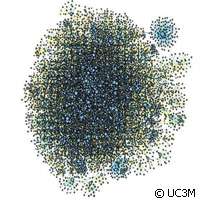Study finds human communication is 'bursty'

Researchers in Spain have investigated the temporal patterns of human communication and how the latter impacts the spread of information in social networks. The results, published in the journal Physical Review E, show how communication between people comes in bursts.
Led by Universidad Carlos III de Madrid (UC3M), the researchers evaluated the mobile phone calls of 20 million people in Spain. They observed that human communication is 'bursty' and occurs in group conversations. But these 'features have the opposite effects on the reach of information; while bursts hinder propagation at large scales, conversations favour local rapid cascades', the authors write.
'This large volume of data and the extended time period guarantees the representativeness and universality in the results,' says co-author and PhD candidate Giovanna Miritello from the Mathematics Department of UC3M, who has a grant contract from Telefónica I+D.
The bottom line is that human behaviour, which includes communication and other activities, does not occur homogeneously. 'This aspect of human activity which has also been observed in other activities such as e-mail, web page visits and stock market operations governs communication between people,' the researchers say.
The team defined the dynamics of social ties, which they consider to be a quantity that covers both the topological and temporal patterns of human communication.
'This is something very important in the processes such as the diffusion of commercial information, viral marketing and the market trends of products, but also in situations such as the spreading of rumours, opinions, policies, etc.,' says co-author Professor Esteban Moro from the Interdisciplinary Research Group of Complex Systems of the Mathematics Department at UC3M and the Institute for the Mathematical Sciences in Spain.
The data show that the impact of the bursts is to slow down the information diffusion, because extensive periods of inactivity in communication between people increases the probability that information is not passed from one to another.
The findings also reveal that group conservations play a key role in human communication. Despite the fact that communication comes in bursts, these bursts occur at the same time among the members of a social group. So information diffusion picks up the pace within these groups.
Commenting on the objective of the research, Professor Moro says: 'As opposed to the static vision of a social network (who I interact with), our study seeks to understand when and how these social relations are produced.'
Professor Moro and colleagues quantified the impact of the features of the communication process in the diffusion of information. Doing so helped them determine if the communication rhythm between two people enables us to know something about the 'strength' or characteristic of the relation, whether they are a friend, relative, colleague or an acquaintance. It also allowed them to evaluate the impact of these rhythms on the propagation of information in social networks, in processes like viral marketing and product recommendations.
More information: Miritello, G. et al. (2011) 'Dynamical strength of social ties in information spreading'. Phys. Rev. E 83. DOI: 10.1103/PhysRevE.83.045102
Provided by CORDIS

















